Public sector innovation scan of Denmark

Over the past four months the Observatory of Public Sector Innovation (OPSI) has worked together with the Government of Denmark to conduct this Public Sector Innovation Scan.
Learning from public sector innovation: the role of scans
Public sector innovation systems are dynamic and constantly evolving: there is no perfect end point. Regardless of how developed or successful an innovation system is, there is always need for critical reflection on the strengths, weaknesses and opportunities for a public sector innovation. Now more than ever, governments need to innovate to keep up with emerging challenges and reach ambitious aims. In this context, public sector innovation scans are an opportunity to explore how innovation has been leveraged, or can be better leveraged, towards strategic and systemic aims. Compared to public sector innovation studies, innovation scans help quickly gather country-specific experiences of public sector innovation and propose steps to consider for further development, while the in-depth country studies provide a detailed and thorough exploration of how innovation can be driven, stewarded and supported in the public sector.
Public Sector Innovation in Denmark
OPSI, in collaboration with the Danish National Centre for Public Sector Innovation (COI), is thrilled to announce the launch of the Danish Public Sector Innovation Scan. This scan explores the innovation journey of Denmark over the recent decades. Denmark has been one of the first OECD countries to support public sector innovation deliberately and has served as an example for public sector innovation labs worldwide. The innovative actions of the Danish Public Service have awarded the country global recognition for its highly sophisticated welfare state, leadership in digital government, and successful digital economy. Much of this success in public sector innovation can be attributed to the innovators on the front lines: those working directly with citizens, across sectors and levels of government who push for innovation from the bottom-up.
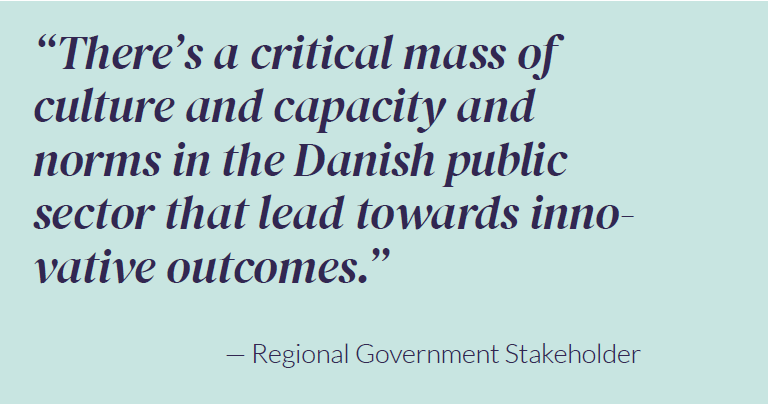
There are a number of key strengths to note in the Danish public sector innovation system. Firstly, Denmark has been a leader for decades in the areas of digitalization and technological innovation, driven in part by a digitalization strategy that was co-developed with stakeholders across levels of government. Furthermore, innovation is a central to the culture of the Danish public sector: part of the everyday norms and practice of public servants. As such, innovation is driven by actors across levels, sectors and hierarchies of government who seek to improve efficiency, effectiveness and value to meet the needs of users. Having decades of experience and success in public sector innovation, the Danish government has an opportunity to leverage considerable capacity in innovation by strategically directing and enabling innovation efforts in the face of the complex challenges that await.
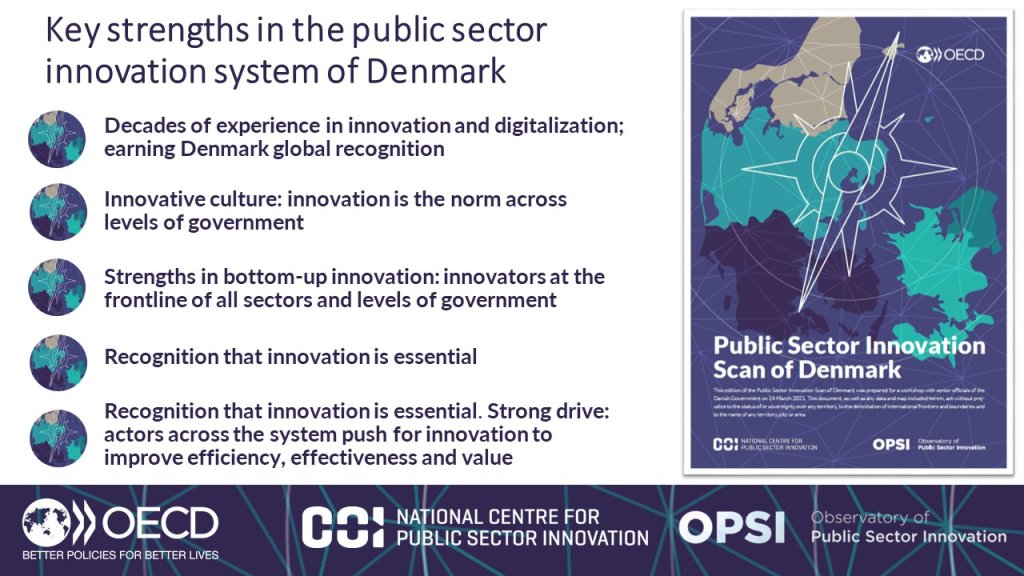
Building on the strengths of the Danish innovation system
Much of the innovative activity in Denmark focuses on the areas of enhancement (upgrading/improving efficiency) and adaptive innovation (responding to changing environments). Evidently, in the COVID-19 context, this enabled the Danish government to adapt and respond quickly: to leverage partnerships with actors across sectors and use the strengths of the system to adapt to changing circumstances. While the abundance of enhancement-oriented and adaptive innovation is common in innovation systems around the world, this often leads governments to a focus on immediate problems and quick wins rather than investing in innovation in the face of more complex challenges.
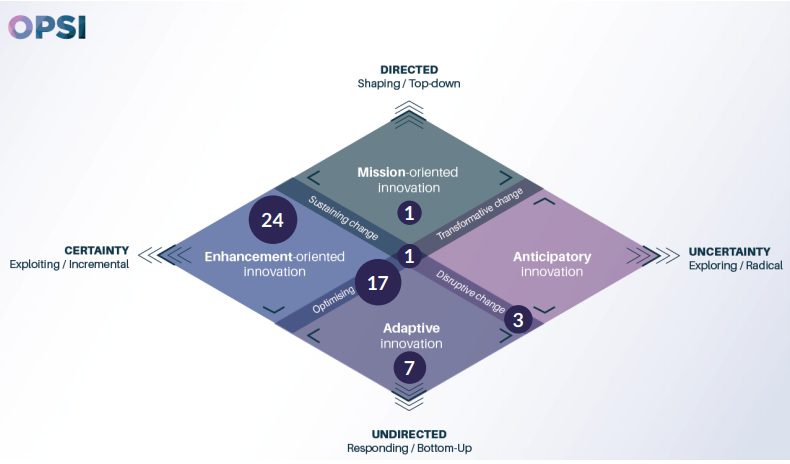
Stewarding Innovation Portfolios
In this context, one of the key opportunities for innovation in Denmark is to build up and steward an innovation portfolio that brings in mission-oriented and anticipatory innovation approaches. Particularly leveraging those approaches in the face of key societal challenges the country is facing. An example of this would be in the realm of climate: the Danish government has committed to 70% CO2 emissions by 2030 – such an ambitious target requires a strategic, deliberate approach to innovation that combines both drive and supports from the top, with mechanisms to enable bottom-up innovation. The same is true for the challenge of ageing populations, which is encountered by both Denmark and many other countries around the world.
Mission-oriented approaches can build on the strengths of bottom-up innovation across levels of government and sectors of society, supported by strategic direction and supports. In conjunction, anticipatory innovation approaches can help to proactively identify emerging challenges and safeguard programmes and policies against future shocks by enabling decision makers to start acting on the implications of a range of scenarios and possible futures early on. Blending this portfolio of innovation methods would enable public servants, and collaborators across sectors to unify around common problems, experiment, test new approaches (e.g. foresight) and invest in innovation efforts that focus beyond immediate challenges into more complex, future challenges. In the face of these complex challenges, innovation needs to be systemically and deliberately supported.
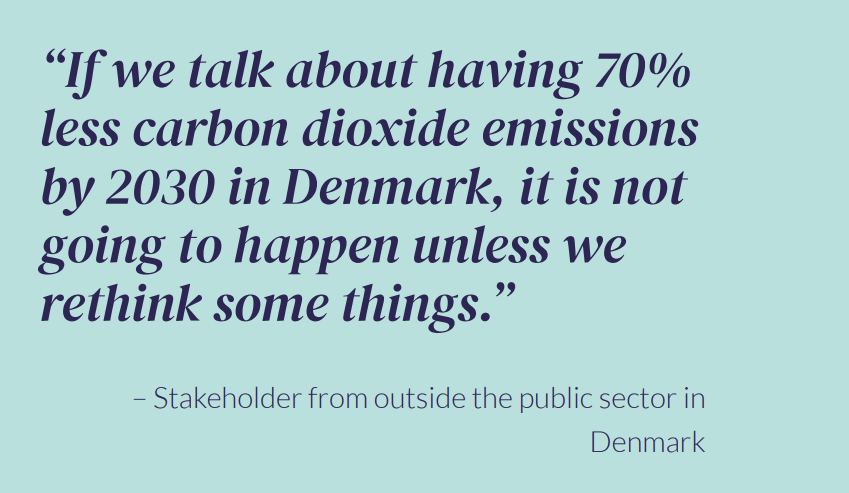
Strategic vision and support for innovation
While innovation is seen as part of the inner-workings and DNA of the Danish public sector, it remains characterised by few government-wide supports and strategic goals. Developing strategic vision and supports for innovation is important for ensuring the success of a balanced innovation portfolio, as well as providing the optimal conditions to enable innovation to happen. Some of these key strategic aspects could include a deliberate innovation strategy that builds on the strengths of the existing innovation system across all levels of government, as well as enabling collaboration with other sectors of society, notably around the key, complex challenges facing Danish society. Moreover, such a strategy and deliberate approach to innovation needs to bring in dedicated funding that goes beyond immediate budget cycles and opens up opportunities for higher risk, longer-term innovation. Additionally, building up capacity around innovation through all stages: problem identification, ideation, development, implementation, evaluation and diffusing lessons is crucial to support successful projects, but also to ensure constant learning from innovation projects, even those that could on the surface be seen as “failures”.

What next?
While this innovation scan offers just a glimpse into the innovation system of Denmark, it is evident that the hard work of innovators at the front lines, paired with innovative culture, drive and a highly professional service have led innovation to excel. These same strengths also offer a foundation on which to build a diverse, deliberate innovation portfolio which dives into the complex challenges of today and the future. This can help Denmark build the capacity of the public sector to face these challenges and steer towards better societal outcomes. As the innovation journey of Denmark continues, there are a number of key principles that can guide both the Danish innovation journey, but also that of other countries which seek to advance their innovation systems:
- Recognise that the public sector innovation system is dynamic and evolving: there is no perfection or endpoint. Regardless of how “successful” a country is at innovation, there are always opportunities to build the capacities of the system.
- Build on the strengths of the system. Use the opportunities available to set strategic direction and establish supports to enable innovation on the front lines.
- Gather around common goals and challenges. The COVID-19 crisis demonstrated how a common challenge can gather innovators across the system to innovate – the same can be done for other complex societal challenges.
- Invest in constant learning. Innovation is a bumpy road, often the biggest learnings come from failures – establishing evaluation frameworks and systemic learning loops is crucial to make the most of innovation efforts.
- Invest in the future. There is a logical tendency to support innovation that shows immediate results. However, the complexity of problems ahead demands an investment in future-oriented innovation that deliberately engages with complex futures.
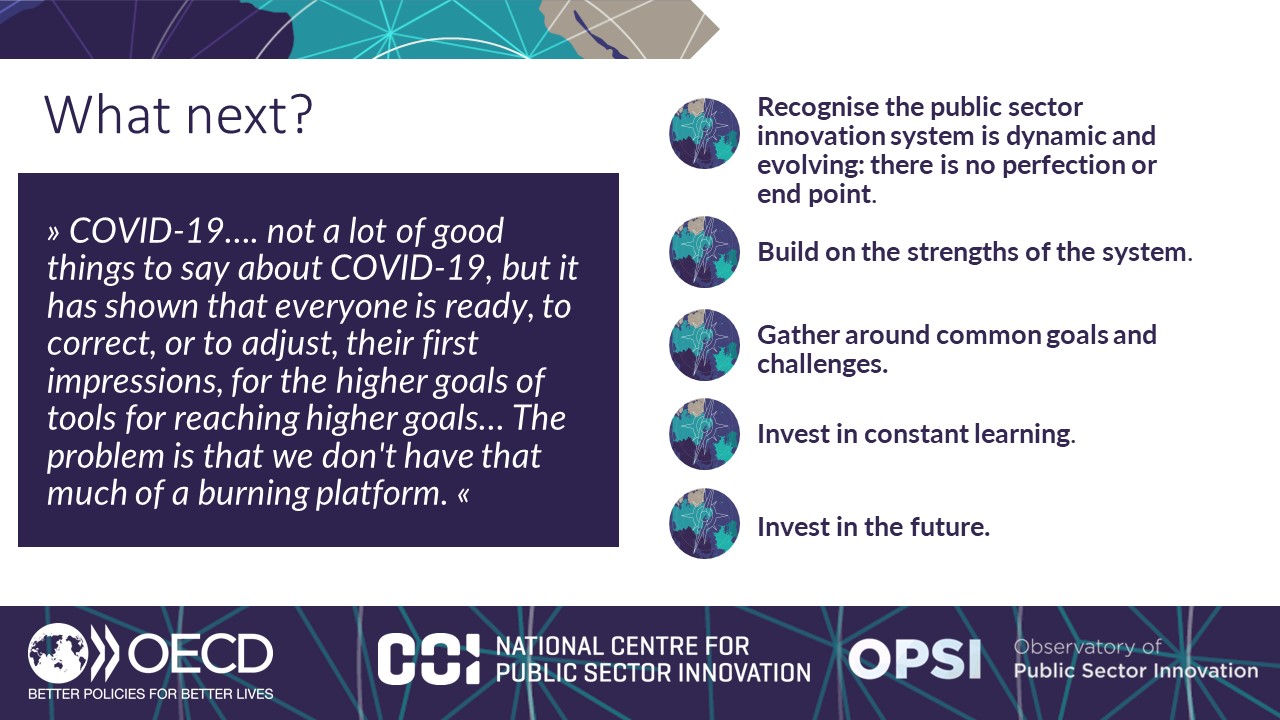
While this innovation scan focuses on the innovation journey of Denmark, successes, lessons learned and principles identified can be applied across country contexts. To read more about the Danish public sector innovation system, you can access the full innovation scan here.
If you are interested in OPSI’s work on public sector innovation scans and studies, please contact us at [email protected].












